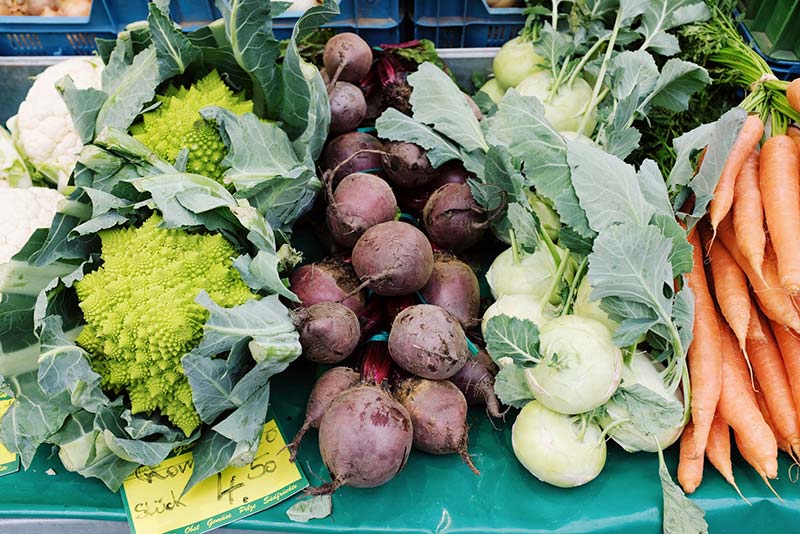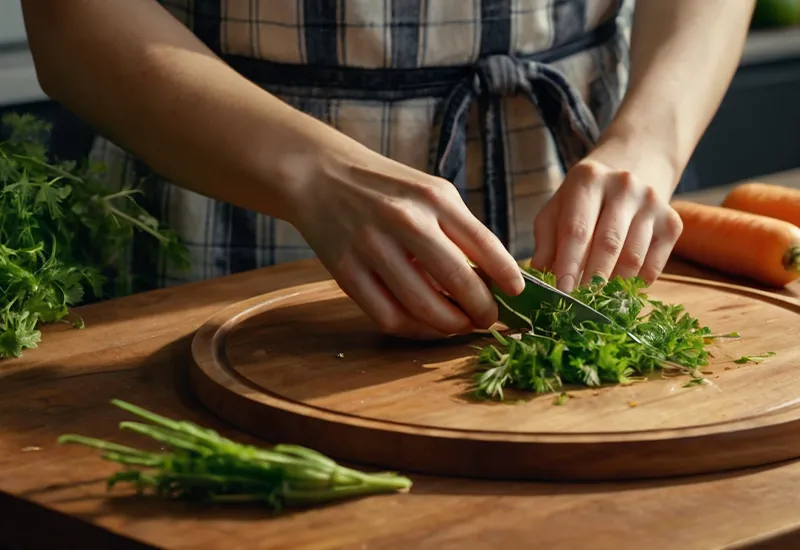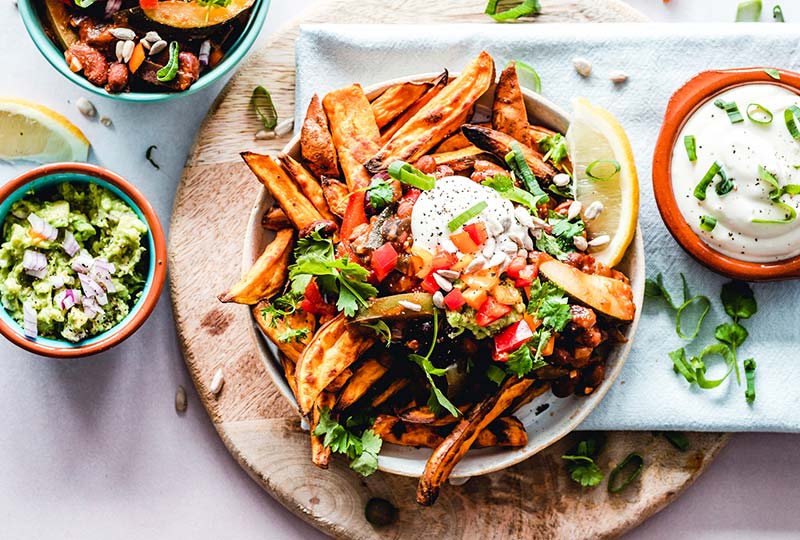How can you actually cook sustainably and eat in a climate-friendly way? And why is this so important? The food sector is responsible for around 40 percent of Europe's greenhouse gas emissions, which are the main accelerator of climate change. Climate change are.1
Ultimately, we are jeopardizing our own food security through our cooking habits. Fortunately, more and more people want to initiate small positive changes in their lives and try to improve their diet. to make everyday life more sustainable. This is especially true for the meals that are served.
In this article, I'll show you how you can cook in a more environmentally friendly way with the simplest tips and tricks and save your ecological footprint in the kitchen. Let's go!
15 tips: How can you cook more sustainably?
We can all wield a wooden spoon and make a valuable contribution to more environmentally friendly cooking in our society.
Simply use the following tips now! They relate to both the Production and Purchasing of food, to which Storage and the Preparationas well as cleaning and tidying the kitchen.
1. regional instead of global
By Prefer food from your region, you avoid long transportation routes by ship, truck or plane. So make a conscious decision to buy local food that (can) grow in Germany or even in your immediate vicinity.
Thereby also automatically reduces the associated resource consumption and at the same time you also promote the companies from "your corner" and strengthen the regional economy.
2. seasonal instead of year-round
Broccoli and cauliflower, for example, are in season from June to October. Outside of this period, their cultivation is longer transportation routes or energy-intensive greenhouses connected. This is another reason why they are generally more expensive when they are not in season.
Simply use this seasonal calendar* as a clear aid for permanent seasonal shopping. With the Weekly markets you will then have a great place to go for seasonal food of regional origin.
3. vegetable instead of animal
Whole books could be written about this tip for sustainable cooking. I'll try to keep it short: to produce one animal calorie, an average of seven plant calories are consumed.2
It would therefore make much more sense to Animal feedthat we provide for the animals in the Factory Farming so that we can eat their meat, eggs and milk.
At the same time, we would Deforestation of the rainforests counteractwhich have to make way for the cultivation of soy as animal feed and for new pastures.
Pb ecological, ethical or health-related: there are so many more good Reasons to eat a plant-based diet. Apart from the linked article, I can also offer you these two contributions to the heart:
4. organic instead of conventional
If you want to cook sustainably, you should also consciously Products with an organic background over conventional products. In this way, you support farms with organic farmingwhich decelerates its products a little bit, but for that environmental and resource-saving manufacture.
This is how no or hardly any pesticides and also the Animal welfare is a top priority. Of course, organic food is not beyond reproach, but it is convincing because it is natural, contains fewer harmful substances and tastes much better. Based on the Organic seal you can easily identify them.
5. fresh instead of processed

The more unprocessed, the more sustainable. Get your food as fresh and whole as possible. Ready meals or processed products from the supermarket already have a longer production process, including the CO2 impact. They are also usually packed with sugar or preservatives.
A good guide is therefore provided by the respective List of ingredients - The shorter and more natural it is, the better.
6. loose, instead of packed in plastic
Everyone knows the problem with the Plastic waste in the environment. Our diet, with vast amounts of packaged ready-made products and quick to-go snacksplays a decisive role in this.
So if you want to cook sustainably, you should already have Make a conscious effort to avoid plastic when shopping. Buy food in bulk as much as possible. This works in the Organic and supermarket really good with a bit of practice. It is even easier on Weekly markets and in the Unpacked Store.
Simply take such preserving jars*, such stainless steel cans*, these fruit and vegetable nets* and be sure to take a jute bag or rucksack with you when you go shopping.
Here again I have further articles ready for you:
- Zero Waste Basic Equipment
- Zero Waste Lifestyle
- Living plastic-free - Here's how
- Getting started with the Zero Waste lifestyle
7. conscious instead of wasteful
Be aware that every food has a story. Some are traveled halfway around the worldothers have Huge amounts of clean water consumeduntil they are on your plate.
Food waste is also a massive problem in our world. Throwaway Society. Every year in Germany alone, over 18 million tons of food thrown in the trash. This corresponds to almost one third of total food consumption.
To make your personal Reduce food wastefor example, you can simply Shop according to plan. Write down what you want to eat in the coming week. And shop strictly according to your shopping list and avoid spontaneous purchases.
Tip: Did you know that you can also save food, enjoy it for free and distribute it to friends? With FoodSharing this works very simply.
8. store food in an energy efficient way
Not only the food itself, but also the Energy that is associated with them in your household should be appreciated in the context of sustainable cooking.
The basis for storing your acquisitions from the supermarket is usually your Refrigerator in the sun. Make sure that it is not placed in the sun or near a heater, otherwise it will consume huge amounts of energy. Ideally, it should be exactly the right size for your household. The fuller it is, the lower the energy consumption.
By then also sorting the food correctly into the respective refrigerator compartmentyou are even more environmentally friendly on the road - and can use the Making food last even longer. Here is a brief overview:
- Refrigerator door (about 10° C): Ideal for butter, sauces, milk or drinks.
- Top shelf (about 8° C): Ideal for jam, hard cheese or cucumbers.
- Medium compartment (about 5° C): Ideal for cottage cheese, yogurt or cheese.
- Lower compartment (about 2° C): Ideal for perishables, such as meat or fish.
- Vegetable compartment (about 10 - 12 ° C): Ideal for strawberries, spinach, broccoli or leaf salads.
9. save electricity during preparation
Of course, processing fresh food also costs some energy, at the latest during preparation in the kitchen. If you make a lasagne in the oven, for example, you can use the Use residual heat and simply turn it off 2-3 minutes earlier before you take your food out. It works in a similar way with the oven.
Saving electricity at homealso works by using the Cool leftovers from hot meals outside the fridge before you put them in. The heart of your kitchen then has to use less energy to equalize the temperature.
10. save water when cooking
Water you can drink with your meals directly, as well as indirectly save. Directly, for example, by placing food in a bowl with water and do not wash under the running tap.
Indirectly, by eating only or more of the foods that do not cause high water consumption during production. Potatoes, carrots, strawberries, apples and green salad for example.
Here, on the other hand, is a brief overview with extremely water-intensive foodswhich you should rather not enjoy at all or only in moderation:
- Chocolate
- Roasted coffee
- Beef
- Butter
- Cheese
- Avocados
Tip: At Save water in the home you will get even more inspiration!
11. use environmentally friendly cooking utensils
The cooking spoon you wield should be as Made from durable material and rapidly renewable raw materials exist. Also pay attention to the FSC certification and other seals for wood from sustainable forestry.
So you conserve natural resources and save yourself from constantly buying new ones. So if a kitchen appliance breaks, you should take the opportunity to replace it with a sustainable alternative. I can recommend the following, for example these kitchen utensils made from cherry wood*.
Tip: Nowadays, many kitchen appliances are powered by batteries or electricity for convenience. But do you really need an electric citrus juicer or automatic salt and pepper grinders? If you have two healthy hands, you can rely on a Manual juicer made of wood* and Manual mills* change
12. utilize leftovers

If you want to cook sustainably, you must not lose track of the Lose food in your "warehouse" that is about to expire. Otherwise, an unnecessary amount ends up in the garbage can and ruins the entire production effort. And it's also unnecessarily expensive!
By only buying what you really need, you are already laying the foundation for as little superfluous food as possible in the fridge. But by also buying the last Utilize leftovers you round off your conscious cooking behavior. Many things can still be Salads, soups or spreads process.
I join in our Thermomix* for example, always an unbelievable Delicious pesto made from carrot greens. For many people, the latter ends up in the garbage can too quickly.
13. proper disposal
Even if you consciously avoid waste, it cannot always be completely avoided. Therefore, make sure that you, even after cooking, your Separate waste correctly.
In order to achieve the best (namely fresh compost!) from your organic waste, you should definitely get yourself a Create compost pile.
If you have less space or no garden of your own I can also give you a such a worm box* recommend. Earthworms break down organic food waste into fertile soil in just a few weeks, which can be used to grow fruit and vegetables on the balcony or in the garden, for example.
Tip: Did you know that some foods can be easily propagated on the windowsill? Ginger for example! In the article Multiply foodyou can learn more about it.
14. environmentally friendly cleaning and cleaning
Now you've cooked sustainably and enjoyed your meal, but the Kitchen still looks like a battlefield. You can also make your cooking even more environmentally friendly!
Use for example Wooden dishwashing brushes with sisal bristles*that do not use any plastic at all. Also the Dishwashing liquid you can make yourself from ivy - it works perfectly!
However, I would advise you to only wash by hand if you only need to clean a few parts. You should definitely wash larger quantities in the dishwasheras the appliances are now much more water-efficient than hand washing.
Tip: If you wash dishes by hand, please do not do so under a running faucet. Instead, fill a bowl with water and wash plates, cutlery, etc. in it.
15. internalize the advantages of sustainable cooking
Sustainable living has so many benefits that it's impossible to include them all in a short list. Nevertheless, I would like to give you at least my key motivators for climate and environmentally friendly cooking in order to stay on the ball in the long term:
- Guarantee food security for future generations
- Produce and consume healthy food
- Promote organic farming and small farms
- Waste less food and save money (see save money through sustainability)
- Protect environment (see Environmental protection in everyday life)
- …
Can you think of any other tips for sustainable cooking? Then always give it to me in the comments!
Sustainable and climate-friendly cooking for a permanently better world

Each of us can be both part of the Environmental problems of our time or be part of their solution - the decision is up to you. I think that these tips will give you enough inspiration to cook even more sustainably in the future.
Browse for a good start also through our Book "Kochen fürs Klima". (is available here*)
"Reason starts in the kitchen."
Friedrich Wilhelm Nietzsche, German philosopher (1844-1900)
Do you have any questions, suggestions or other environmental tips about cooking? Then I look forward to your comment.
Stay sustainable,

PS: If you need a little more motivation for a more environmentally friendly kitchen, you should definitely check out this Docs about factory farming view. After all, a picture is worth a thousand words. Highly recommended is the Dominion film.
References:
- Klima-Kollekte - Kirchlicher Kompensationsfonds gemeinnützige GmbH: Nutrition as a key driver of climate change, available at https://klima-kollekte.de/vermeiden-reduzieren/ernaehrung. [18.11.2024]. ↩︎
- Verbraucherzentrale Hamburg: Climate-friendly eating - here's how (as of 12.11.2024), available at https://www.vzhh.de/themen/lebensmittel-ernaehrung/klimafreundliche-ernaehrung/klimafreundlich-essen-so-gehts. [18.11.2024]. ↩︎








Greetings Christoph! I have made the experience that a sustainable cooking at the beginning is usually also a strong taste change. With many less sustainable foods from the supermarket, we are really trained to go to the many artificial flavor enhancers. If you then slowly but surely the step into sustainable cooking was, can only be at the beginning of quite a difference. But with time it will definitely be easier. In any case, I thank you very much for your useful tips in terms of sustainable cooking. Keep up the good work and thank you!
Moin Julius! Absolutely, it's a change of taste that you have to get used to. In the end, you should just be open to new things and realize that a change doesn't happen overnight, but step by step. Today, I'm glad that the change has introduced me to so many new different, delicious meals.
Best regards
Christoph